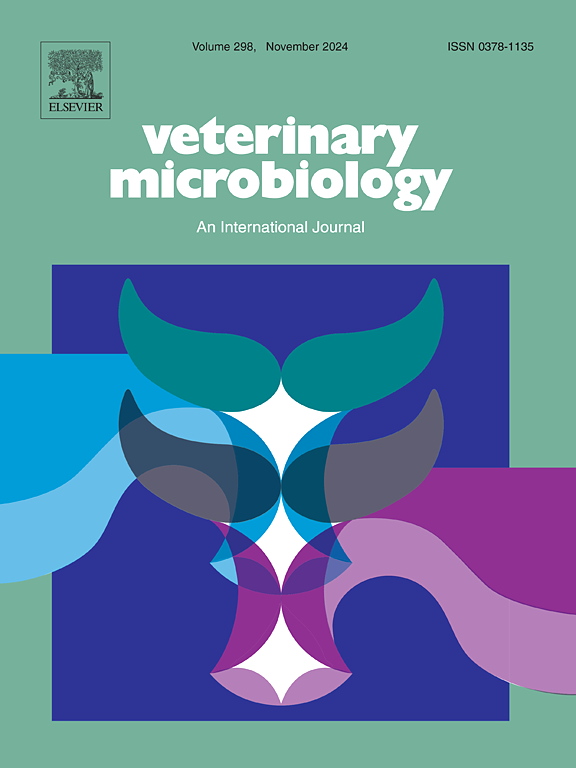Potency of two chimeric vaccine candidates derived from the classical swine fever GPE– vaccine strain against a circulating virus strain isolated in Japan
IF 2.4
2区 农林科学
Q3 MICROBIOLOGY
引用次数: 0
Abstract
A classical swine fever (CSF) vaccine combining high potency and an immunological marker for differentiating infected animals from vaccinated animals facilitates disease control and provides proof of eradication to promote international pig trade. Previously, CSF virus (CSFV) recombinant live vaccine strains, guinea-pig exaltation of Newcastle disease virus-negative strain vaccine [vGPE– (genotype 1.1)], were developed with the Erns gene replaced by non-CSF pestiviruses (Pronghorn antelope or Phocoena pestiviruses). We evaluated the potency of these marker vaccines against a Japanese circulating CSFV strain (genotype 2.1), which is genetically distant from the vaccine strain. Pigs were experimentally vaccinated with the vGPE– and two marker vaccine strains. All vaccinated and unvaccinated pigs were challenged with CSFV JPN/1/2018 at 26 days post-vaccination. The clinical signs and viral titers in blood and oral swabs were monitored for three weeks post-challenge, and antibodies against CSFV E2 and Erns were detected using commercial enzyme-linked immunosorbent assay kits. Unvaccinated pigs showed typical CSF clinical signs and viremia, and one pig died at 19 days post-challenge. Meanwhile, none of the vaccinated pigs showed any clinical signs, and the replication of infectious virus was substantially suppressed. Both vGPE–-vaccinated and unvaccinated pigs had CSFV E2 and Erns antibodies after vaccination and virus challenge; meanwhile, notably, marker-vaccinated pigs had only E2 antibodies, while both E2 and Erns antibodies detected only after the challenge. In conclusion, the marker vaccine strains provided protective immunity to suppress clinical signs, viremia, and virus excretion, comparable to the GPE– live vaccine, and successfully differentiated infection from vaccination.
求助全文
约1分钟内获得全文
求助全文
来源期刊

Veterinary microbiology
农林科学-兽医学
CiteScore
5.90
自引率
6.10%
发文量
221
审稿时长
52 days
期刊介绍:
Veterinary Microbiology is concerned with microbial (bacterial, fungal, viral) diseases of domesticated vertebrate animals (livestock, companion animals, fur-bearing animals, game, poultry, fish) that supply food, other useful products or companionship. In addition, Microbial diseases of wild animals living in captivity, or as members of the feral fauna will also be considered if the infections are of interest because of their interrelation with humans (zoonoses) and/or domestic animals. Studies of antimicrobial resistance are also included, provided that the results represent a substantial advance in knowledge. Authors are strongly encouraged to read - prior to submission - the Editorials (''Scope or cope'' and ''Scope or cope II'') published previously in the journal. The Editors reserve the right to suggest submission to another journal for those papers which they feel would be more appropriate for consideration by that journal.
Original research papers of high quality and novelty on aspects of control, host response, molecular biology, pathogenesis, prevention, and treatment of microbial diseases of animals are published. Papers dealing primarily with immunology, epidemiology, molecular biology and antiviral or microbial agents will only be considered if they demonstrate a clear impact on a disease. Papers focusing solely on diagnostic techniques (such as another PCR protocol or ELISA) will not be published - focus should be on a microorganism and not on a particular technique. Papers only reporting microbial sequences, transcriptomics data, or proteomics data will not be considered unless the results represent a substantial advance in knowledge.
Drug trial papers will be considered if they have general application or significance. Papers on the identification of microorganisms will also be considered, but detailed taxonomic studies do not fall within the scope of the journal. Case reports will not be published, unless they have general application or contain novel aspects. Papers of geographically limited interest, which repeat what had been established elsewhere will not be considered. The readership of the journal is global.
 求助内容:
求助内容: 应助结果提醒方式:
应助结果提醒方式:


